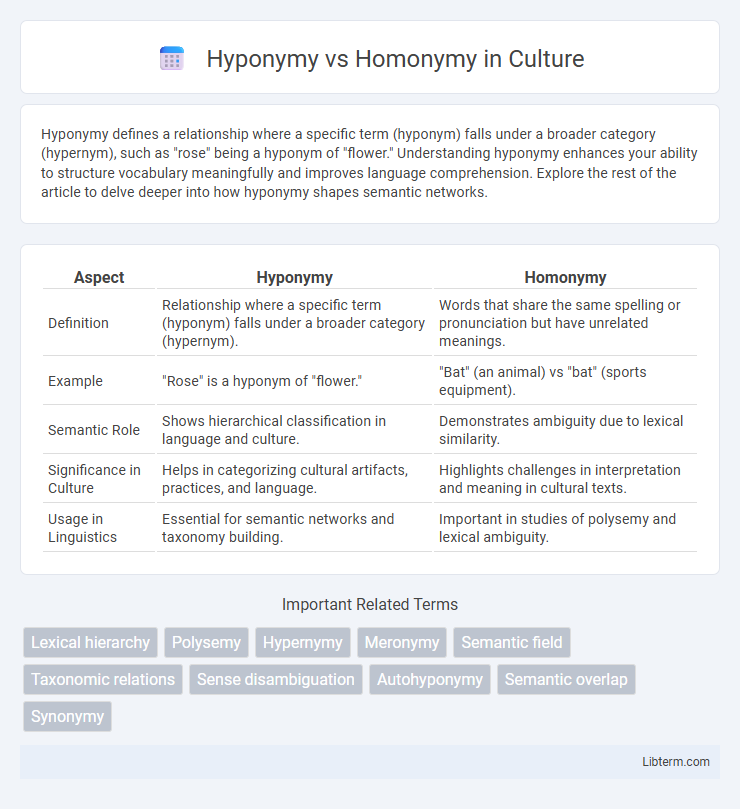Hyponymy defines a relationship where a specific term (hyponym) falls under a broader category (hypernym), such as "rose" being a hyponym of "flower." Understanding hyponymy enhances your ability to structure vocabulary meaningfully and improves language comprehension. Explore the rest of the article to delve deeper into how hyponymy shapes semantic networks.
Table of Comparison
| Aspect | Hyponymy | Homonymy |
|---|---|---|
| Definition | Relationship where a specific term (hyponym) falls under a broader category (hypernym). | Words that share the same spelling or pronunciation but have unrelated meanings. |
| Example | "Rose" is a hyponym of "flower." | "Bat" (an animal) vs "bat" (sports equipment). |
| Semantic Role | Shows hierarchical classification in language and culture. | Demonstrates ambiguity due to lexical similarity. |
| Significance in Culture | Helps in categorizing cultural artifacts, practices, and language. | Highlights challenges in interpretation and meaning in cultural texts. |
| Usage in Linguistics | Essential for semantic networks and taxonomy building. | Important in studies of polysemy and lexical ambiguity. |
Introduction to Hyponymy and Homonymy
Hyponymy refers to a semantic relationship where a specific term (hyponym) is included within the meaning of a more general term (hypernym), such as "rose" being a hyponym of "flower." Homonymy occurs when two words share the same spelling or pronunciation but have different meanings, like "bat" (an animal) and "bat" (a sports implement). Understanding hyponymy and homonymy is essential for accurate language processing and lexical semantics in natural language understanding.
Defining Hyponymy
Hyponymy is a semantic relationship where a more specific term (hyponym) is included within a broader category (hypernym), such as "rose" being a hyponym of "flower." This hierarchical structure allows precise classification and organization of vocabulary based on categorical subsumption. Homonymy, in contrast, involves words with identical forms but unrelated meanings, highlighting the difference between semantic specificity and lexical ambiguity.
Defining Homonymy
Homonymy occurs when two or more words share the same spelling or pronunciation but have different meanings, such as "bat" (an animal) and "bat" (a piece of sports equipment). This linguistic phenomenon can lead to ambiguity in language processing and comprehension. Understanding homonymy is crucial for tasks like natural language processing and semantic analysis to correctly interpret context and meaning.
Key Differences Between Hyponymy and Homonymy
Hyponymy involves a hierarchical relationship where a specific term (hyponym) falls under a broader category (hypernym), such as "rose" being a hyponym of "flower." Homonymy, on the other hand, occurs when two words share the same spelling or pronunciation but have unrelated meanings, like "bat" (the animal) and "bat" (the sports equipment). The key difference lies in semantic relatedness: hyponyms share a meaning hierarchy, whereas homonyms are semantically unrelated despite surface similarities.
Examples of Hyponymy in Language
Hyponymy refers to the relationship between a more specific term and a broader category, such as "rose" being a hyponym of "flower" and "sparrow" a hyponym of "bird." These hierarchical relationships help structure vocabulary by showing how specific items fit within general classes, like "apple" as a hyponym under "fruit" or "sedan" under "car." Understanding hyponymy enhances language comprehension by clarifying semantic fields and enabling precise word choice within conversations and texts.
Examples of Homonymy in Language
Homonymy occurs when words share the same spelling or pronunciation but have unrelated meanings, such as "bat" meaning a flying mammal or a piece of sports equipment. Another example is "bank," which can refer to a financial institution or the side of a river. This phenomenon creates ambiguity in language, requiring context for accurate interpretation.
The Role of Context in Understanding Meaning
Hyponymy involves hierarchical relationships where a specific term (hyponym) falls under a broader category (hypernym), and its meaning is clarified by its categorical context. Homonymy features words that share spelling or pronunciation but differ entirely in meaning, making contextual cues essential to disambiguate them. Effective interpretation of both hyponymy and homonymy relies heavily on surrounding linguistic context, enabling accurate semantic understanding.
Importance of Hyponymy and Homonymy in Linguistics
Hyponymy plays a crucial role in linguistics by establishing hierarchical relationships between words, such as "rose" being a hyponym of "flower," which aids in semantic categorization and language comprehension. Homonymy, involving words that share spelling or pronunciation but differ in meaning, like "bat" (animal) and "bat" (sports equipment), highlights the complexity of language processing and lexical ambiguity. Understanding both hyponymy and homonymy is essential for lexical semantics, language learning, computational linguistics, and improving natural language understanding systems.
Common Misconceptions and Confusions
Hyponymy involves a hierarchical relationship where one term (hyponym) is a subtype of another (hypernym), such as "rose" being a hyponym of "flower," whereas homonymy refers to different words that share the same spelling or pronunciation but have unrelated meanings, like "bat" (the animal) and "bat" (the sports equipment). A common misconception is confusing hyponyms with synonyms, incorrectly assuming all related words share similar meanings rather than a category-specific relationship. Another frequent confusion arises when homonyms are mistaken for polysemous words, which actually denote a single word with multiple related meanings rather than completely unrelated ones.
Conclusion: Significance in Language Studies
Hyponymy reveals hierarchical relationships between words by indicating specificity, enhancing semantic networks and vocabulary acquisition. Homonymy highlights the complexity of language, where identical forms have unrelated meanings, challenging lexical disambiguation and comprehension. Understanding both phenomena deepens linguistic analysis, benefiting lexicography, natural language processing, and language education.
Hyponymy Infographic

 libterm.com
libterm.com